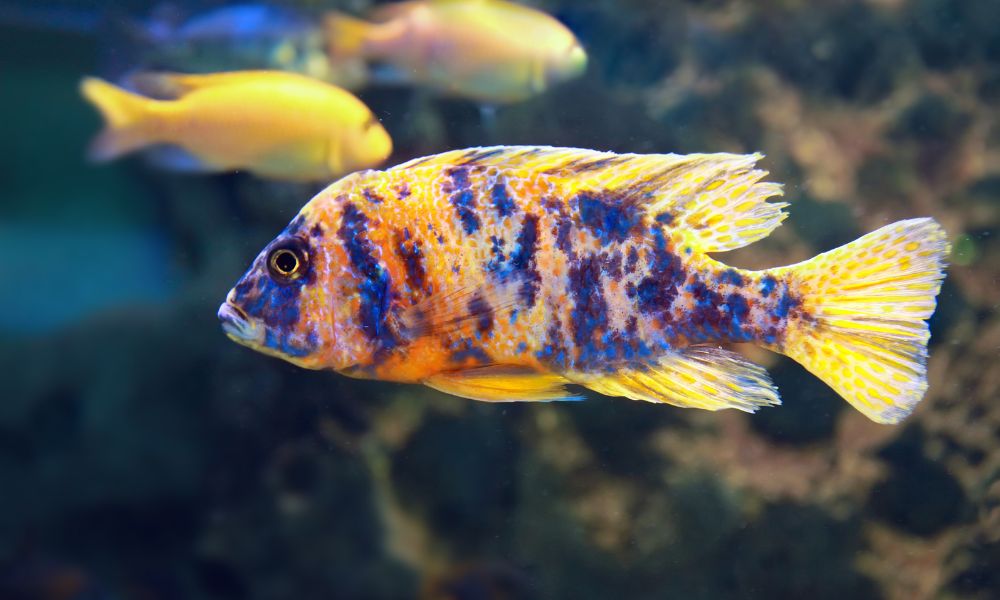
Peacock cichlids tend to be fairly aggressive fish, so for optimal care it's best to house them alone in their own tank. If you are experienced enough with these species however, they can be kept alongside hap cichlids from Lake Malawi as well as other mbuna cichlids from Malawi.
Zebra Loaches make excellent tank mates as they are peaceful fish with similar water parameters and enjoy hiding out in caves and rocks, lessening aggression significantly.
Plecos
Plecostomus, commonly referred to as plecos, are easy and beautiful fish to care for aquarium fish. While they make a fantastic addition, plecos should be kept with larger bottom-dwellers such as Oscar fish or freshwater eels for maximum effect.
Plecos are great tankmates for other species such as Guppies or Mollies, as well as smaller fish with distinct coloring such as Electric Blue Haps (Haplochromis ahli). These schooling fish will not fight with each other and also won't monopolize hiding spots within the tank.
Bristlenose Plecos can be successfully bred in captivity with some effort and dedication. Since they are mouthbrooders, it's essential that their breeding tank be equipped with proper filtration and warm temperatures (80-82 F), along with ample substrate (sand or rock) and hiding places for the fish to hide away in.
Food will attract female fish into a breeding tank where they'll lay their eggs in a cave. Once hatching occurs, female will carry her young around for several weeks until it's time for release into their environment.
Red Tail Shark
Red Tail Sharks tend to be aggressive and territorial fish, so they should only be housed with fish that have similar needs and temperaments. Too curious, aggressive or bottom-dwellers could get harassed or chased away by them; fast swimmers like Red Tail Sharks may attack smaller species out of nowhere! For safety's sake, tankmates should generally be of similar body sizes but large semi-aggressive ones can work too, provided there's enough aquarium space.
Bristle Nose Plecos make an excellent tankmate choice, as they are peaceful algae eaters that do not display any predatory behavior. Furthermore, they help maintain the cleanliness of an aquarium community that includes Red Tail Sharks.
Rasboras make excellent tankmates for Red Tail Sharks as they are shoaling species that swim together. Rasboras generally don't pester other tank mates and will remain out of the shark's territory; yet fast swimmers if threatened or attacked.
Proper care of Red Tail Sharks includes providing them with a large aquarium equipped with hiding spaces, dark-colored substrate that mimics their natural habitat, and proper temperature and pH parameters for water conditions like temperature and pH levels. Furthermore, regular monitoring is crucial as is providing them with nutritious protein-rich plant-based foods.
Botia Loach
Botia Loachs (Yasuhikotakia modesta) are popular freshwater fish found in aquarium stores. With their hardiness and beautiful color patterns ranging from blues to greys with green tinted fins and tails, these hardy little guys make for excellent starter tank owners.
These fish prefer living in groups, or "shoals", of their own species. Being kept alone may lead to depression or withdrawal and aggressive behaviors from them; to avoid this happening it is recommended to always keep at least three of each kind together or five or more would be ideal.
Like other Botia genus species, these fish do not tend to be shy but also less active than some Loach species. They prefer fine sand substrate and an aquarium filled with hiding places stocked with plenty of coral species for shelter. Sharp-edged decor should be avoided as this fish has a tendency of fitting through tight spaces.
These fish are omnivorous, taking to various types of live, sinking pelleted food or flake foods without issue - from mosquito larvae to brine shrimp, daphnia or algae wafers - as well as snails themselves! For this reason they make an excellent solution to controlling snail populations.
Red Tide Shark
Red Tide Sharks are large, athletic and aggressive by nature and may become territorial when it comes to their habitat. By providing appropriate care and conditions in their tank environment, Red Tide Sharks will coexist more peacefully with other species in a community aquarium; any tankmates should also share similar dietary needs so there isn't too much competition over food sources.
Congo Tetras are an ideal option, not only because they co-exist well with Red Tail Sharks but also due to their complementary colors in an aquarium tank. Their small size means that they can occupy different sections without aggressive displays taking place; furthermore, being very active, Congo Tetras help agitate the surface water for improved oxygenation of an aquarium environment.
Mollies make an excellent tankmate choice as they not only coexist well with Red Tail Sharks but can add color and vibrancy to any aquarium. As an added benefit, mollies help graze on algae present in your tank as well as provide benefits in eating any. For optimal results it is wise to feed sinking algae pellets as a supplement so as not to outcompete Red Tail Sharks with regard to food source consumption.
Pearl Gourami are excellent tank mates for Red Tide Sharks as they are attractive fish with peaceful personalities that co-habit the same parts of an aquarium without acting aggressively towards each other. They will live together happily without being aggressive towards one another.
